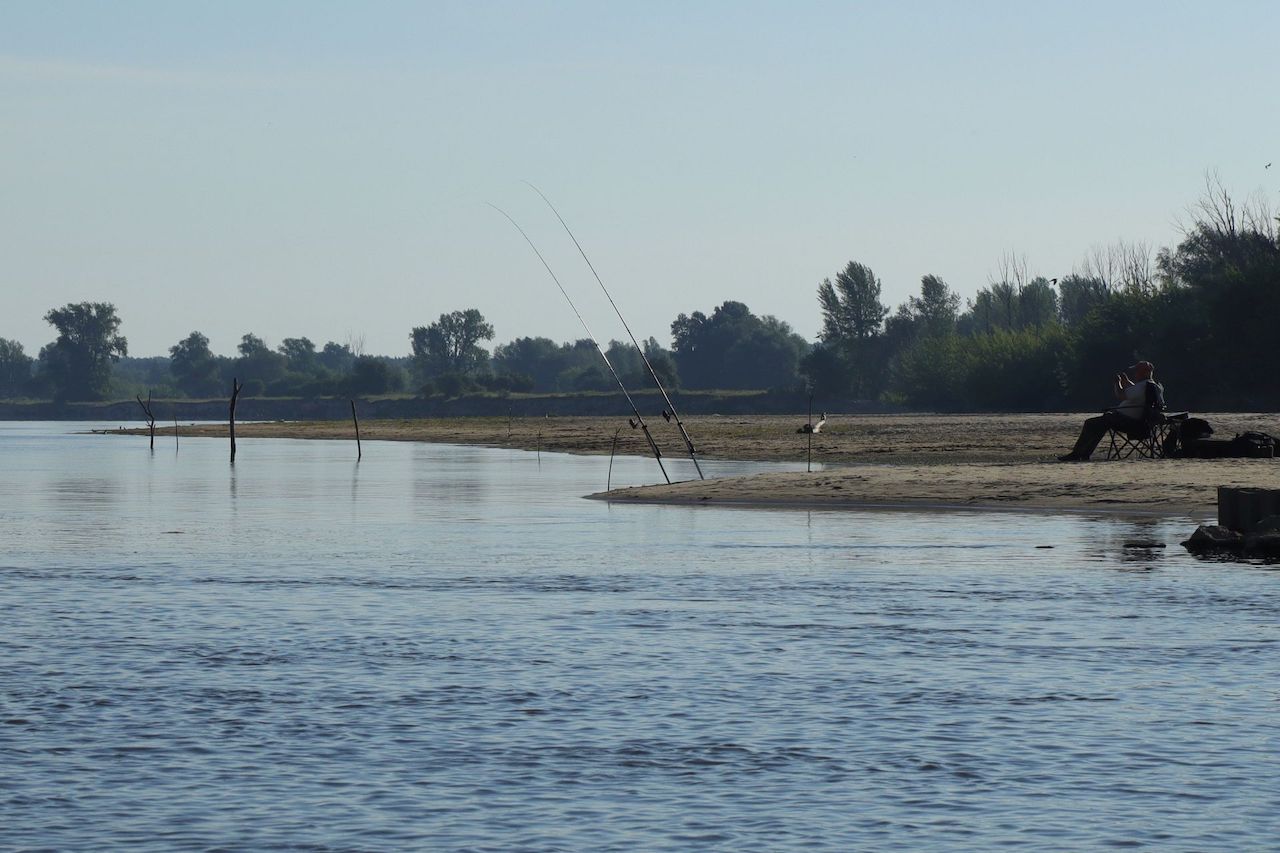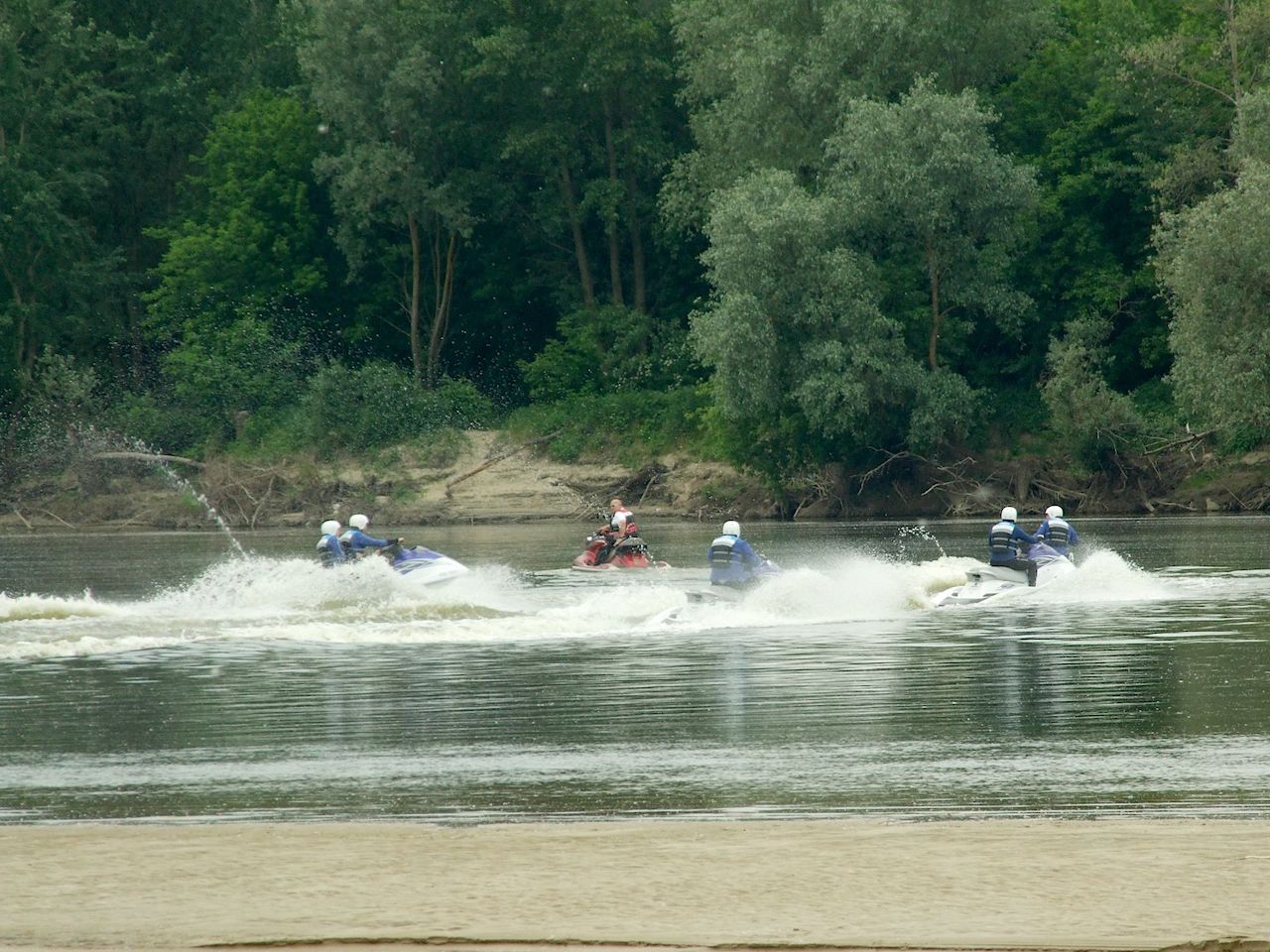

The first breeding season of gulls, terns and other charadriiforms on the middle Vistula, in which we carried out active protection tasks as part of the project entitled: “Active protection of endangered species of Charadriiformes on the Vistula River islands: implementation of selected protection tasks in the area of SPA Dolina Środowej Wisły PLB140004”, is behind us.

A pair of common gulls in an area protected by an electric fence
In 2022, on the part of the Vistula River between Puławy (km. 371 of the river waterway) and the mouth of the Pilica River (km. 457 of the waterway), taking into account the species of birds under our protection, nearly 120 pairs of common gull (Larus canus), over 3,000 pairs of black-headed gull (Chroicocephalus ridibundus), a few pairs of Mediterranean gull (Ichthyaetus melanocephalus), about 600 pairs of common tern (Sterna hirundo), about 200 pairs of little tern (Sternula albifrons) and several pairs of oystercatcher (Haematopus ostralegus) nested.

Black-headed gull colony protected by an electric fence
We took active protective measures to cover all pairs of common gulls (half of them by protecting the breeding grounds with electric fences, the rest by placing wooden dummy eggs in the nests and simultaneous incubation of the original eggs in incubators).

Common gull eggs in the incubator drawer
We protected the remaining species mainly by fencing the most valuable breeding grounds with electric fences. As a result, we did not find brood losses in any of the species listed as a result of predation by American minks (Neovision vision), raccoon dogs (Nyctereutes procyonoides), red foxes (Vulpes vulpes) or other mammalian predators, which was one of the short-term goals of the project. The mortality rate of adults on breeding grounds within the 86-kilometre section of the river covered by our activities was also negligible (at most a few birds for each of the listed species, for the black-headed gull - several dozen birds, which is still a very small value considering its abundance). Furthermore, we did not find that any of the deaths were due to mammalian predation. The lack of large river floods in 2022 meant that the hatching success of gulls, terns and oystercatchers was higher than in previous years, even taking into account those with active protection. The chicks' survival rate and breeding success were also at a high level, although taking into account the favorable hydrological conditions prevailing this year on the Vistula (small, short-lived water rising level) and the lack of losses as a result of mammalian predation (which until recently was the cause of almost zero breeding success for most gull species here) could be even higher. This did not happen for several reasons. Some of them were specific to this year and important only for some species of birds, but most were common to all charadriiforms and may be important in the context of subsequent breeding seasons.

Mediterranean gull chicks Ichthyaetus melanocephalus
The first significant factor limiting the breeding success of some Charadriiformes in 2022 was very specific weather conditions. After a warm and quite dry early spring, in the first decade of May, we recorded a very cold beginning of May (between May 2 and May 7, in the Vistula valley between Dęblin and Tarnów) with the prevailing night temperature between +2 degrees C and +4 degrees C, which is comparable to the temperature in a refrigerator. All the birds that started laying eggs at that time and did not incubate them until the clutch was completed suffered heavy losses. A good example was the common gull, for which the first decade of May is the period of laying eggs for a large part of the Vistula River population. Females of this species lay three eggs, at two-day intervals, and incubation begins after the second or third, last egg in the clutch is laid.

Little tern chick Sternula albifrons
Thus, birds that started laying eggs between 2.05.-4.05. were exposed to heavy losses already at this stage of reproduction. Most of the eggs laid during this period did not hatch, and post mortem analysis of the development of the embryos in these eggs confirmed that death occurred shortly after egg laying. A similar problem was also faced by some pairs of black-headed gulls (the fraction of birds including the youngest individuals, which started breeding last, and those that laid eggs much earlier, then lost their clutches and just started laying replacement clutches) and, to a lesser extent, single oystercatcher pairs.

Oystercatcher chick Haematopus ostralegus
The second major break in the weather took place at the very end of the breeding season of charadriiforms on the Vistula River, at the turn of June and July (between June 27 and July 10, 2022). It had significant effects on virtually all charadriiforms that were still incubating eggs or (mostly) rearing chicks at that time. Long-lasting very high temperatures (over +30 degrees C in the shade) have caused several very violent storms, with very strong winds, and above all with extremely strong downpours of rain and heavy hail (on different days between Puławy and the mouth of the Pilica River).

Adult common gull with already flying fledglings
After one of such violent phenomena, one of the most important breeding grounds for gulls on "our" part of the river, located on a large, flat island, mainly sandy, looked like a small canyon. The downpour, which lasted about an hour, carved several "gorges" on the island, each with a width of several to several meters and a depth of 30 cm to 50-60 cm, and the flat island's terrain was history. Unfortunately, apart from changing horizontal shape of the island, rainstorms caused local mass mortality of chicks of gulls, terns, oystercatchers and other charadriiforms. After one downpour we found 29 dead, mostly almost fledged chicks of common gulls. A similar fate befell a large number of chicks of common terns (at a similar stage of development as common gulls), little terns (at a younger age) and single almost fledged young oystercatchers and little ringed and ringed plovers.

Hot air over the Vistula riverbanks
The second important factor negatively influencing the breeding success this year, especially in the colonies of the common gull and, to a lesser extent, in the black-headed gull colonies, was the mass appearance of blackflies (small blood-sucking insects belonging to the Simuliidae family), which started this year on the middle Vistula River at the beginning of the second decade of May and lasted exceptionally long, until June 15-17, with the peak of swarming between May 23 and June 5. Some pairs of breeding gulls left the broods at that time, others tried to continue breeding but left the nests unattended for long periods of time. The hatchlings, deprived of the physical protection of their parents (who circled high above the colony, thus protecting themselves from the mass insect bites), were "almost sucked" alive by swarms of blackflies, resulting in a slow death.

(so-called the "blackflie eye" probably the result of an allergic reaction to the toxin contained in the saliva of the flies
The third factor causing locally large losses was the tourist pressure. The low water level of the river, combined with generally nice weather, caused a mass "invasion" of tourists to the islands every weekend from the beginning of May, and during the holiday season the notorious, permanent and completely uncontrolled presence of people on the charadriiform breeding grounds in the middle Vistula riverbed. The presence of people, often entire families with children and dogs running off-leash on islands with bird colonies all day long and the regular presence of quads, off-road bikes and off-road vehicles on low sandbanks and the constant noise of personal watercraft around the breeding grounds meant that losses in tern colonies were locally high. They resulted either from the physical destruction of the clutch by a vehicle or dogs, or (more often) from overheating of eggs and heat death of chicks deprived of parental protection from the sun. To a lesser extent, we also recorded losses due to this in broods of gulls, oystercatchers and both species of plovers.

The growing human pressure on the breeding grounds of gulls and terns in the middle Vistula riverbed has been observed for 9-10 years. In the last three or four years, however, this process has clearly accelerated, and the uncompromising actions and the increasingly aggressive attitude of those enjoying the charms of the riverbed suggest that in the near future this will be one of the most important reasons that will make difficult, if not impossible, to rebuild the Vistula populations of endangered bird species.

Not wanting to end the report of the breeding season of gulls and terns on the Vistula with a gloomy vision, where predation by American minks, foxes, raccoon dogs or raccoons will not be the main threat to common gulls, little terns and oystercatchers (which we are trying to deal with), but the pressure of the most invasive species in the world that is man (which will be even more difficult to deal with ...), we would like to inform you that all chicks of common gulls from artificially incubated eggs in 2022 have found care. Most often it was the care of their own parents, sometimes other adults of the same species. The last eight hatchlings this year, however, found very good care in the aviaries of the "Ptasie Horyzonty". " Foundation. The conditions there and the concern of employees (or rather positively "freaky" hobbyists) for the well-being of gulls and other charadriiforms allow them to safely grow up until they can be safely released into the wild. Thank you very much for your help, we will remember you in the future :)

Anglers and tourists can be a serious threat to hatching chicks, especially in hot weather